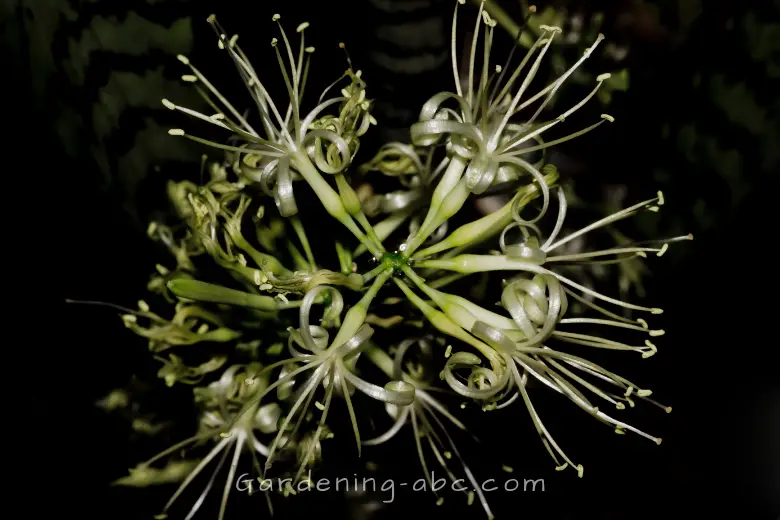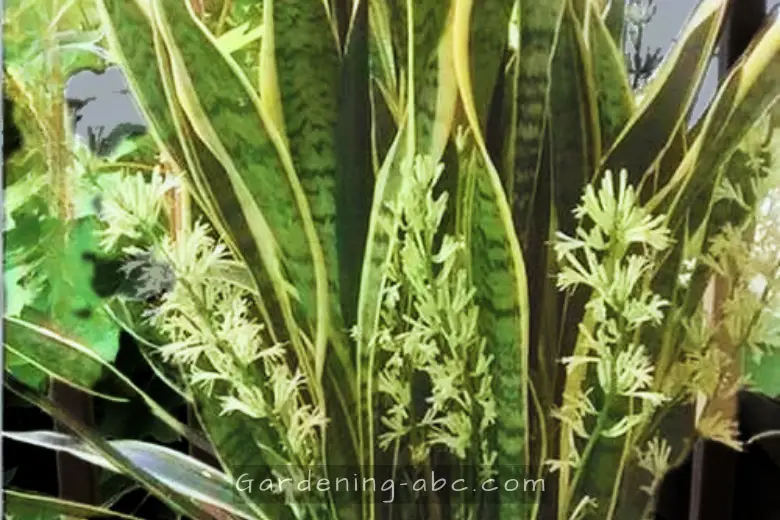We use affiliate links to run our site. When you buy through links on our site, we may earn an affiliate commission, without any added cost to you. Learn more
Snake plants, also known as Sansevieria, are beloved for their air-purifying properties, resilience, and ease of care. However, one aspect of these plants that often goes overlooked is their stunning flowers. Yes, snake plants can flower!
In this article, we’ll dive into the fascinating world of snake plant flowers, exploring their rarity, appearance, fragrance, and more.
What Are Snake Plant Flowers?
While the snake plant is primarily grown for its striking foliage, it can also produce small clusters of flowers, typically once a year.
The flowers are usually white or cream-colored and grow on tall stalks that can reach up to three feet in height. The flowers are relatively small and have thin petals that resemble those of a lily or honeysuckle.
If you’re lucky enough to catch the snake plant in bloom, you may also notice a sweet fragrance emanating from the flowers.
The flowers are typically fragrant at night and contain sticky nectar that resembles dew drops on the blossom stems.
However, it’s worth noting that the snake plant flower is not typically used in floral arrangements, as it can be quite delicate.
How to Care for the Snake Plant Flower
If you’re hoping to see your snake plant flower, there are a few things you can do to encourage it. As mentioned earlier, neglect can sometimes stimulate the plant to bloom. Allowing the soil to dry out completely before watering and providing bright, indirect sunlight can also help encourage flowering.
That being said, snake plants are relatively low-maintenance, and no special care is needed to encourage blooming. As long as you provide your plant with bright, indirect light and water it sparingly, it should thrive.
In fact, snake plants can often grow too quickly and become root-bound, which can actually stimulate blooming.
In terms of soil requirements, snake plants prefer well-draining soil, but they can also thrive in potting mix as long as it has adequate drainage.
Additionally, snake plants don’t require a lot of fertilizer or added nutrients to grow. Over-fertilizing can actually harm the plant, so it’s best to err on the side of caution.
Flower Appearance
When Snake Plants do bloom, they produce tall flower stalks covered in small, greenish-white flowers. The flowers are fragrant and resemble lilies or honeysuckles.
Fragrance
The Snake Plant flower is not only visually stunning, but it also has a mesmerizing fragrance that fills the air at night. The aroma is sweet and subtle, with hints of vanilla and jasmine.
The fragrance is released when the flowers open at night and remains until the morning, giving the home a pleasant and calming scent.
The flowers also a sweet nectar that attracts various pollinators. The nectar is a vital source of food for insects such as bees and butterflies, making Snake Plants not only a stunning ornamental addition to your home but also an essential addition to the ecosystem.

Using Snake Plant Flowers in Arrangements
Snake Plant flowers are delicate and not suitable for flower arrangements. Enjoy them on the plant as they are. After the flowers die back, prune the long flowering stalk at the base to conserve energy and present a tidier appearance.
Snake Plant After Flowering:
After the Snake Plant flowers have run their course, they will begin to wilt and fall off. However, the stalk that once held the flowers will continue to grow and develop into berries.
These berries are a beautiful addition to the plant’s overall appearance and will eventually drop, giving way to new growth.
Please note that the flowering process does not signify the death of the plant. In fact, the Snake Plant will continue to thrive and grow, even after the flowers have faded.
With proper care and attention, the plant will continue to produce new growth, providing beauty and ornamental value to your home.
Popular Snake Plant Varieties:
While snake plants are all beautiful, some varieties are especially popular. Here are a few of our favorites:
Sansevieria Hahnii
This variety of snake plant, also known as “Bird’s Nest Sansevieria,” has short, compact leaves that grow in a rosette shape. It’s perfect for small spaces or as a desk plant.
Sansevieria Cylindrica
As its name suggests, this snake plant has cylindrical leaves that grow upright. It’s a striking plant that can add height to any space.
Sansevieria Moonshine
If you’re looking for a snake plant with a silvery-blue tint, look no further than the Sansevieria Moonshine. Its leaves are long and slender, making it an elegant addition to any room.
Sansevieria Black Coral
This variety of snake plant has dark, almost-black leaves that contrast beautifully with its light green stripes. It’s a unique and eye-catching plant that’s sure to be a conversation starter.
Final Thoughts:
Snake plants are a wonderful addition to any home or office, not only for their aesthetic appeal but also for their air-purifying qualities. While their flowering is a rare and exciting event, their long-lasting foliage is a constant source of joy.
Whether you have a green thumb or are just starting out, these hardy plants are a great choice for anyone looking to add some greenery to their space.
We hope this article has been helpful in shedding some light on the fascinating world of snake plants and their flowers.
If you enjoyed reading this post, please share it with your friends and family who may also be interested in learning more about these amazing plants.
And don’t forget to explore more articles on our site for tips and tricks on gardening and plant care. You can also sign up for our Gardening ABC newsletter to receive even more tips and advice on plant care.
Amazon and the Amazon logo are trademarks of Amazon.com, Inc, or its affiliates.

Hi there! My name is Prasenjit and I’m an avid gardener and someone who has grown a passion for growing plants. From my hands-on experience, I have learned what works and what doesn’t. Here I share everything I have learned.
